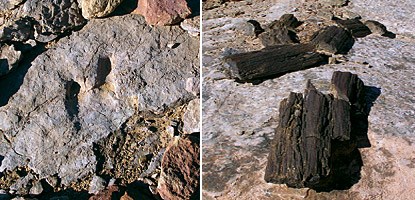
NPS Photos by Gary Cox BY LEN EISENBERG 185 million years ago, during the age of dinosaurs known as the early Jurassic, Utah was a very different place. Instead of rocky deserts, isolated mountains and deep canyons, sand dunes covered the state from end to end. During rainy periods, lakes formed in low areas between the dunes, and life flourished in them. Today that great pile of sand is known as the Navajo Sandstone. It forms the cliff walls of Zion National Park, the petrified dunes of Arches National Park, and mesa tops at the Island in Sky and Horseshoe Canyon districts of Canyonlands. In fact, one of the lakes is preserved at Horseshoe Canyon, revealing evidence of a fascinating ecosystem. If we could travel back in time to this lake, what might we see? Returning to the early Jurassic, we find a sea of sand dunes stabilized by a living carpet of dwarf fern and cryptobiotic soil. From above, the distant glint of silver and gold from a reflected Jurassic sun announces the presence of a chain of lakes. The nearest lake is a few hundred yards wide and nearly a mile long. The lakeshore is lined with stands of conifers and cycads amid meadows of ferns and horsetails. Some of the trees are a foot in diameter and 30 feet high. Walking on the dunes, the thin crust of vegetation easily breaks apart under our feet. It probably wouldn’t take much of a climate shift to dry up the vegetation, the lakes, and set the dunes in motion. It is a sweaty 100 degrees out and a swim sounds good. As we wade into the lake, a group of shrimp-like forms hurry deeper into the water. Some of them have translucent hinged shells on their backs. Vegetated dunes rise above the trees and meadows back from the lakeshore. On one of the dunes a squat, dog-sized reptile is clawing swipes of sand out of a hole. Its short, strong arms have no trouble digging deep into the dune and uncovering a nest of wasp larvae. The creature licks up the larvae, and its thick, bristly hide protects it from the angry parents. On the northern side of the lake, microscopic organisms deposit mats of limy sediment on the lake bottom, which is marked by winding trails of bottom-mining worms and snails. In places, these mats have built up into large microbial mounds. It appears that if the lake level were to rise, the living surface of the mound would keep pace by growing larger. We notice that all of the mounds and most of the mats are on the south-facing side of the lake, where these photosynthesizing organisms receive the most sun. Beyond the mounds we see three-toed dinosaurs walking around, each about the size of a skinny turkey. They could be a group of Segisaurus. One scratches the sand with a toe, then quickly thrusts down its narrow jaws and comes up with a mouthful of sand and a wriggling crustacean. We wade closer to get a better look, but they suddenly raise their heads in unison and bolt. We stand in the shallows amid the horsetails, impressed at how fast they can move.Now a hand-sized green and gold dragonfly hovers a few feet away. It chases a flying bug, but then a young pterosaur, a flying reptile, flashes down and snatches the dragonfly from the air. As it flies away, gulping down its meal, we see that the pterosaur has the wingspan of a raven and a long stiff tail that ends in a wedge-shaped web of skin. Eventually, we arrive offshore of the main area of meadows and trees. In and out of the shadows we see head-high dinosaurs moving–possibly a group of Ammosaurus. Some are on all fours pulling at ferns; others rise up on thick hind legs to reach the tops of plants. There are two or three larger individuals and a similar number of smaller ones, probably adults and offspring. While several make their way to the shoreline for a drink, one or more of the adults watch for danger. In the Jurassic world, it is not long in coming. A large, meat-eating theropod makes a charge from the trees. The herbivores spin and rush along the shore, galloping on all fours. The predator has the angle and plows into the group, snatching at the smallest. It is butted off by the largest adult who turns in confrontation and blows a braying honk at its foe. The meat-eater is too small to take on this heavy, enraged animal and dodges around it to pursue the rest of the herd. The adult rushes after, braying and honking. The animals soon disappear from view without any sign of slowing. Whew! Not wanting to push our luck, we swim back to our starting place and return to the present. The Jurassic lake at Horseshoe Canyon is located just east and north of the west side trailhead parking lot (see the bulletin boards for more information). Fossilized wood, microbial mounds, other plant remains, as well as dinosaur and invertebrate tracks have been found there or in nearby areas. Skeletal remains are very rare in the Navajo Sandstone and none have been found at Horseshoe Canyon. Len Eisenberg is an independent geologist living in Oregon. His main research interest is the Navajo Sandstone, especially the indicators of unusual habitats and events in it. |
Last updated: February 24, 2015
